Enterprise Software Development: Object Relational Mapping Report
VerifiedAdded on 2023/06/08
|9
|1915
|449
Report
AI Summary
This report provides a comprehensive overview of Object Relational Mapping (ORM), a crucial technique in computer programming for bridging the gap between object-oriented programming languages and relational databases. The report begins with an introduction to ORM, highlighting its role in resolving data type mismatches and enabling data conversion between object-oriented and relational models. It delves into the challenges of object-relational mismatch, including granularity issues, inheritance mismatches, identity mismatches, problems in association, and navigation problems. A comparison of ORM with traditional data access techniques is presented, emphasizing the benefits of ORM such as reduced code and improved cache management, along with its limitations. The report then describes various ORM technologies, including Java Persistence API (JPA), Language Integrated Query (LINQ), Hibernate Object Relational Mapping, and RedBeanPHP, outlining their functionalities and applications. The discussion concludes by summarizing the key aspects of ORM and its significance in modern software development, referencing relevant literature to support the analysis.
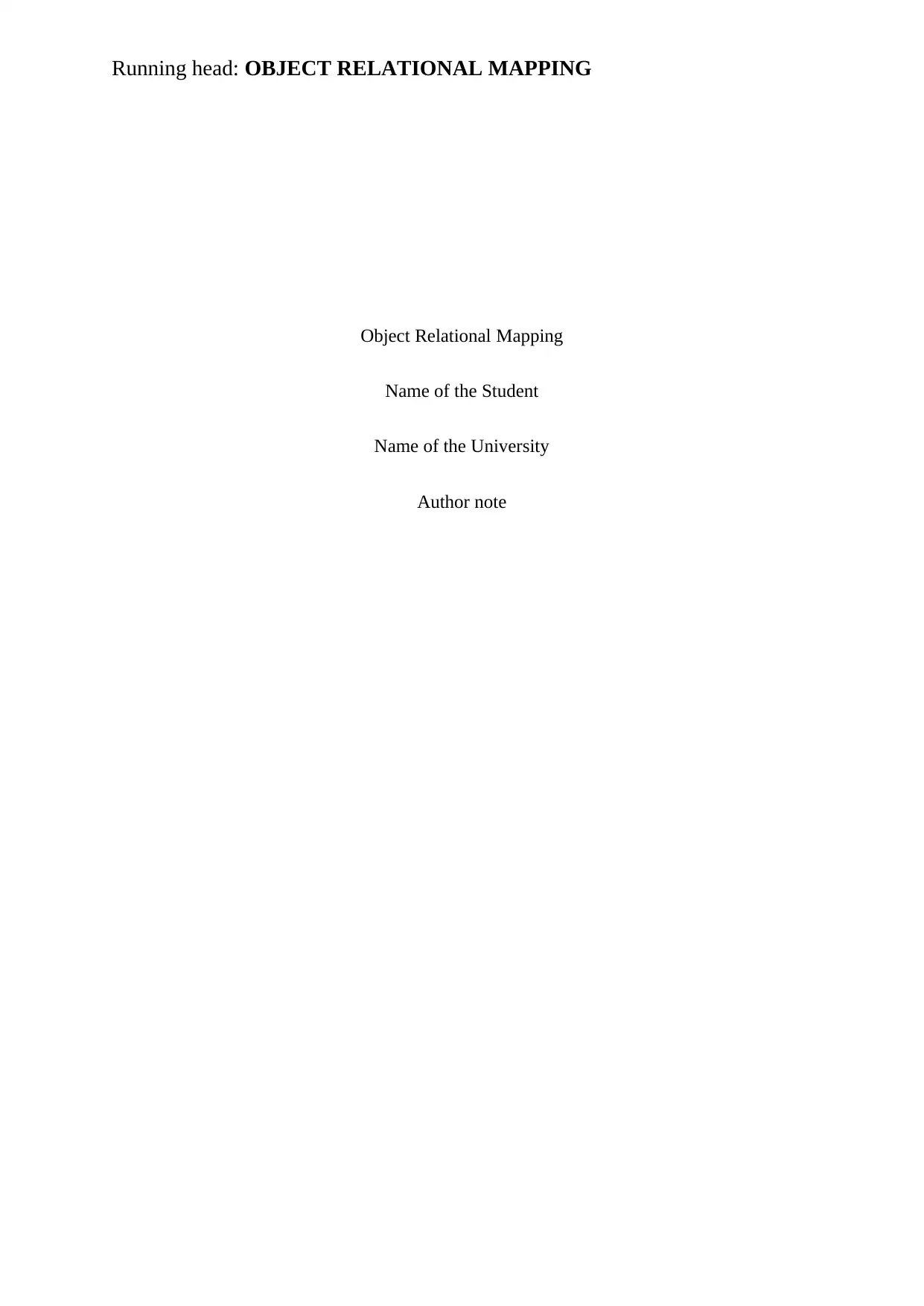
Running head: OBJECT RELATIONAL MAPPING
Object Relational Mapping
Name of the Student
Name of the University
Author note
Object Relational Mapping
Name of the Student
Name of the University
Author note
Paraphrase This Document
Need a fresh take? Get an instant paraphrase of this document with our AI Paraphraser
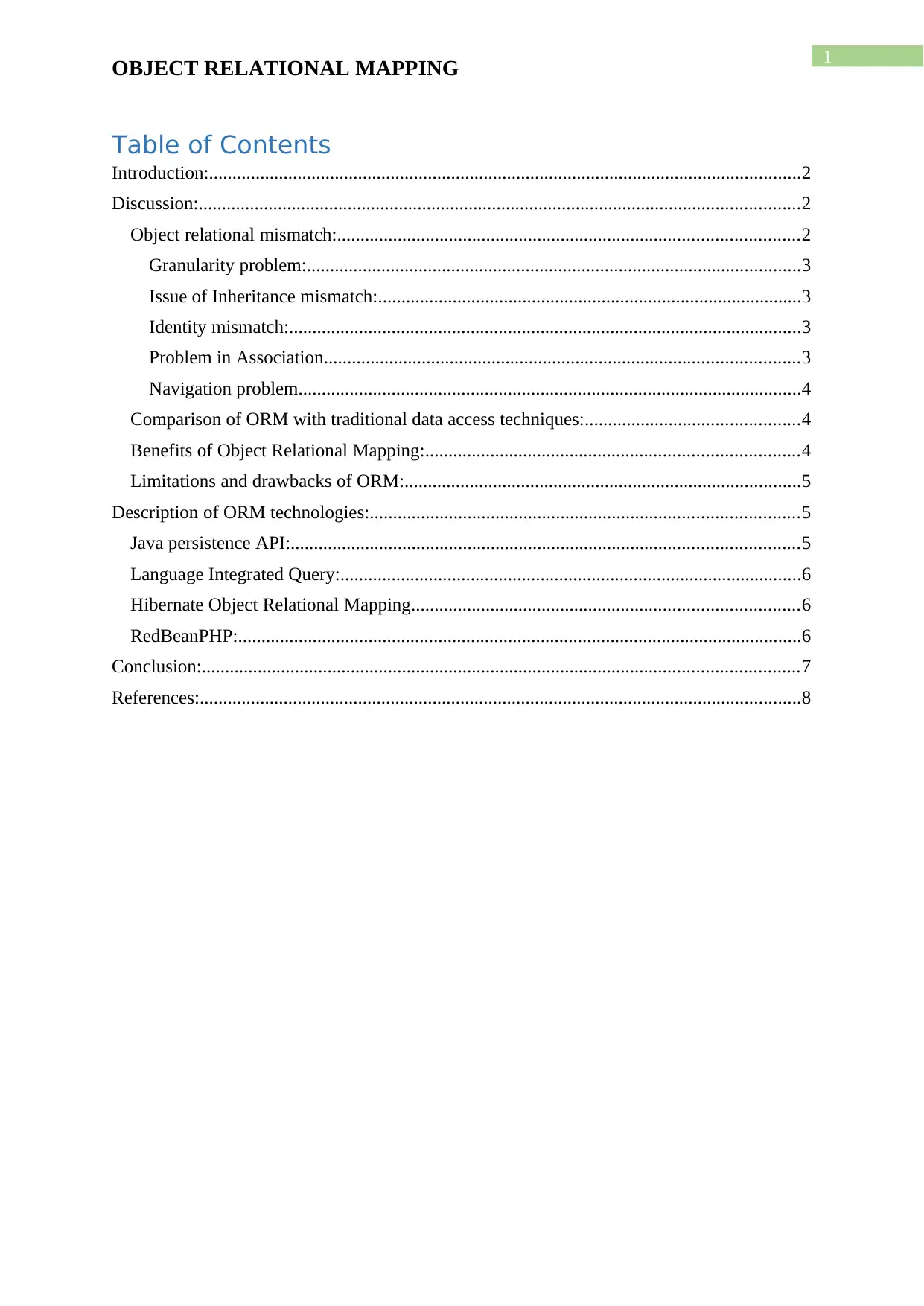
1
OBJECT RELATIONAL MAPPING
Table of Contents
Introduction:...............................................................................................................................2
Discussion:.................................................................................................................................2
Object relational mismatch:...................................................................................................2
Granularity problem:..........................................................................................................3
Issue of Inheritance mismatch:...........................................................................................3
Identity mismatch:..............................................................................................................3
Problem in Association......................................................................................................3
Navigation problem............................................................................................................4
Comparison of ORM with traditional data access techniques:..............................................4
Benefits of Object Relational Mapping:................................................................................4
Limitations and drawbacks of ORM:.....................................................................................5
Description of ORM technologies:............................................................................................5
Java persistence API:.............................................................................................................5
Language Integrated Query:...................................................................................................6
Hibernate Object Relational Mapping...................................................................................6
RedBeanPHP:.........................................................................................................................6
Conclusion:................................................................................................................................7
References:.................................................................................................................................8
OBJECT RELATIONAL MAPPING
Table of Contents
Introduction:...............................................................................................................................2
Discussion:.................................................................................................................................2
Object relational mismatch:...................................................................................................2
Granularity problem:..........................................................................................................3
Issue of Inheritance mismatch:...........................................................................................3
Identity mismatch:..............................................................................................................3
Problem in Association......................................................................................................3
Navigation problem............................................................................................................4
Comparison of ORM with traditional data access techniques:..............................................4
Benefits of Object Relational Mapping:................................................................................4
Limitations and drawbacks of ORM:.....................................................................................5
Description of ORM technologies:............................................................................................5
Java persistence API:.............................................................................................................5
Language Integrated Query:...................................................................................................6
Hibernate Object Relational Mapping...................................................................................6
RedBeanPHP:.........................................................................................................................6
Conclusion:................................................................................................................................7
References:.................................................................................................................................8
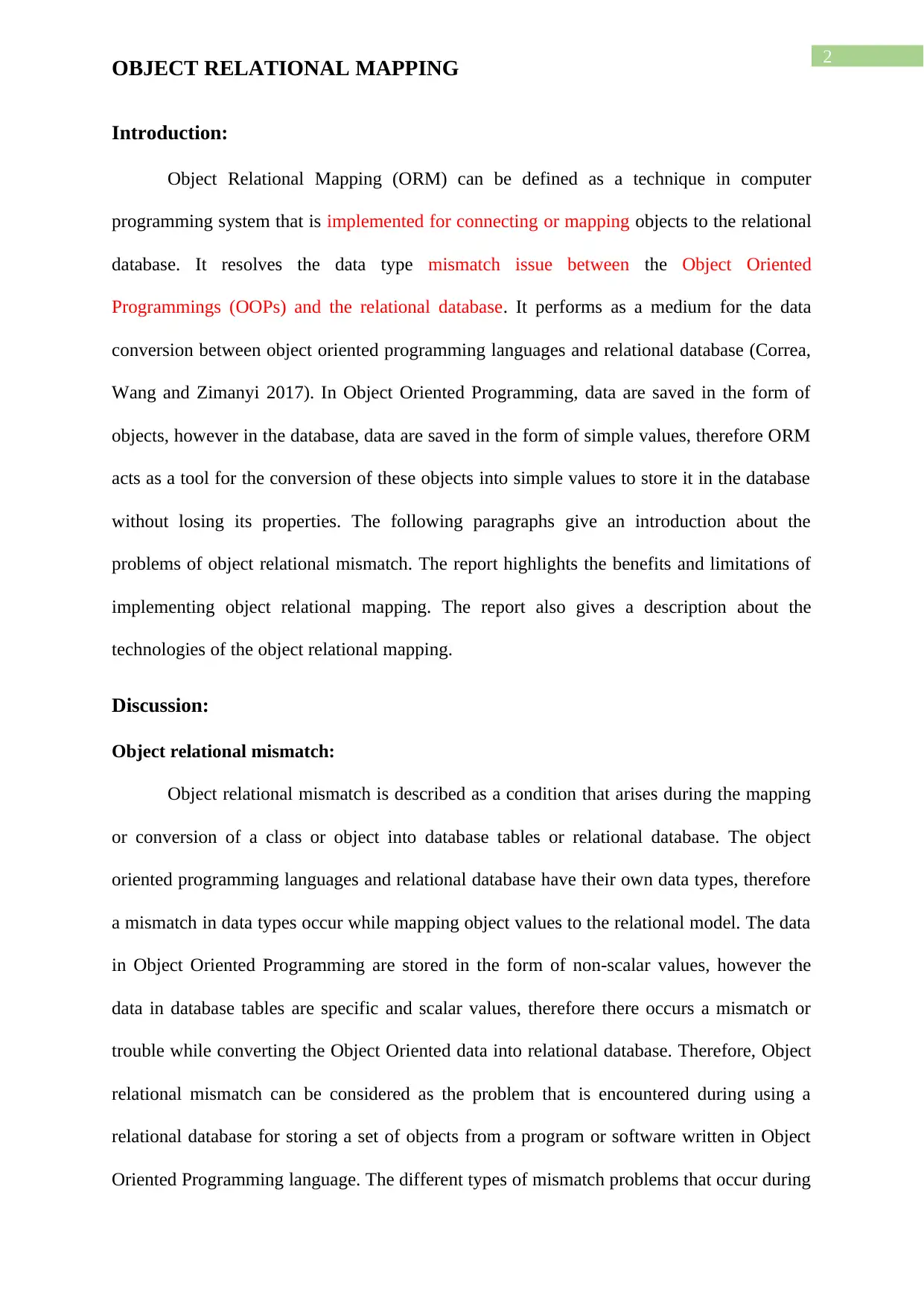
2
OBJECT RELATIONAL MAPPING
Introduction:
Object Relational Mapping (ORM) can be defined as a technique in computer
programming system that is implemented for connecting or mapping objects to the relational
database. It resolves the data type mismatch issue between the Object Oriented
Programmings (OOPs) and the relational database. It performs as a medium for the data
conversion between object oriented programming languages and relational database (Correa,
Wang and Zimanyi 2017). In Object Oriented Programming, data are saved in the form of
objects, however in the database, data are saved in the form of simple values, therefore ORM
acts as a tool for the conversion of these objects into simple values to store it in the database
without losing its properties. The following paragraphs give an introduction about the
problems of object relational mismatch. The report highlights the benefits and limitations of
implementing object relational mapping. The report also gives a description about the
technologies of the object relational mapping.
Discussion:
Object relational mismatch:
Object relational mismatch is described as a condition that arises during the mapping
or conversion of a class or object into database tables or relational database. The object
oriented programming languages and relational database have their own data types, therefore
a mismatch in data types occur while mapping object values to the relational model. The data
in Object Oriented Programming are stored in the form of non-scalar values, however the
data in database tables are specific and scalar values, therefore there occurs a mismatch or
trouble while converting the Object Oriented data into relational database. Therefore, Object
relational mismatch can be considered as the problem that is encountered during using a
relational database for storing a set of objects from a program or software written in Object
Oriented Programming language. The different types of mismatch problems that occur during
OBJECT RELATIONAL MAPPING
Introduction:
Object Relational Mapping (ORM) can be defined as a technique in computer
programming system that is implemented for connecting or mapping objects to the relational
database. It resolves the data type mismatch issue between the Object Oriented
Programmings (OOPs) and the relational database. It performs as a medium for the data
conversion between object oriented programming languages and relational database (Correa,
Wang and Zimanyi 2017). In Object Oriented Programming, data are saved in the form of
objects, however in the database, data are saved in the form of simple values, therefore ORM
acts as a tool for the conversion of these objects into simple values to store it in the database
without losing its properties. The following paragraphs give an introduction about the
problems of object relational mismatch. The report highlights the benefits and limitations of
implementing object relational mapping. The report also gives a description about the
technologies of the object relational mapping.
Discussion:
Object relational mismatch:
Object relational mismatch is described as a condition that arises during the mapping
or conversion of a class or object into database tables or relational database. The object
oriented programming languages and relational database have their own data types, therefore
a mismatch in data types occur while mapping object values to the relational model. The data
in Object Oriented Programming are stored in the form of non-scalar values, however the
data in database tables are specific and scalar values, therefore there occurs a mismatch or
trouble while converting the Object Oriented data into relational database. Therefore, Object
relational mismatch can be considered as the problem that is encountered during using a
relational database for storing a set of objects from a program or software written in Object
Oriented Programming language. The different types of mismatch problems that occur during
⊘ This is a preview!⊘
Do you want full access?
Subscribe today to unlock all pages.

Trusted by 1+ million students worldwide
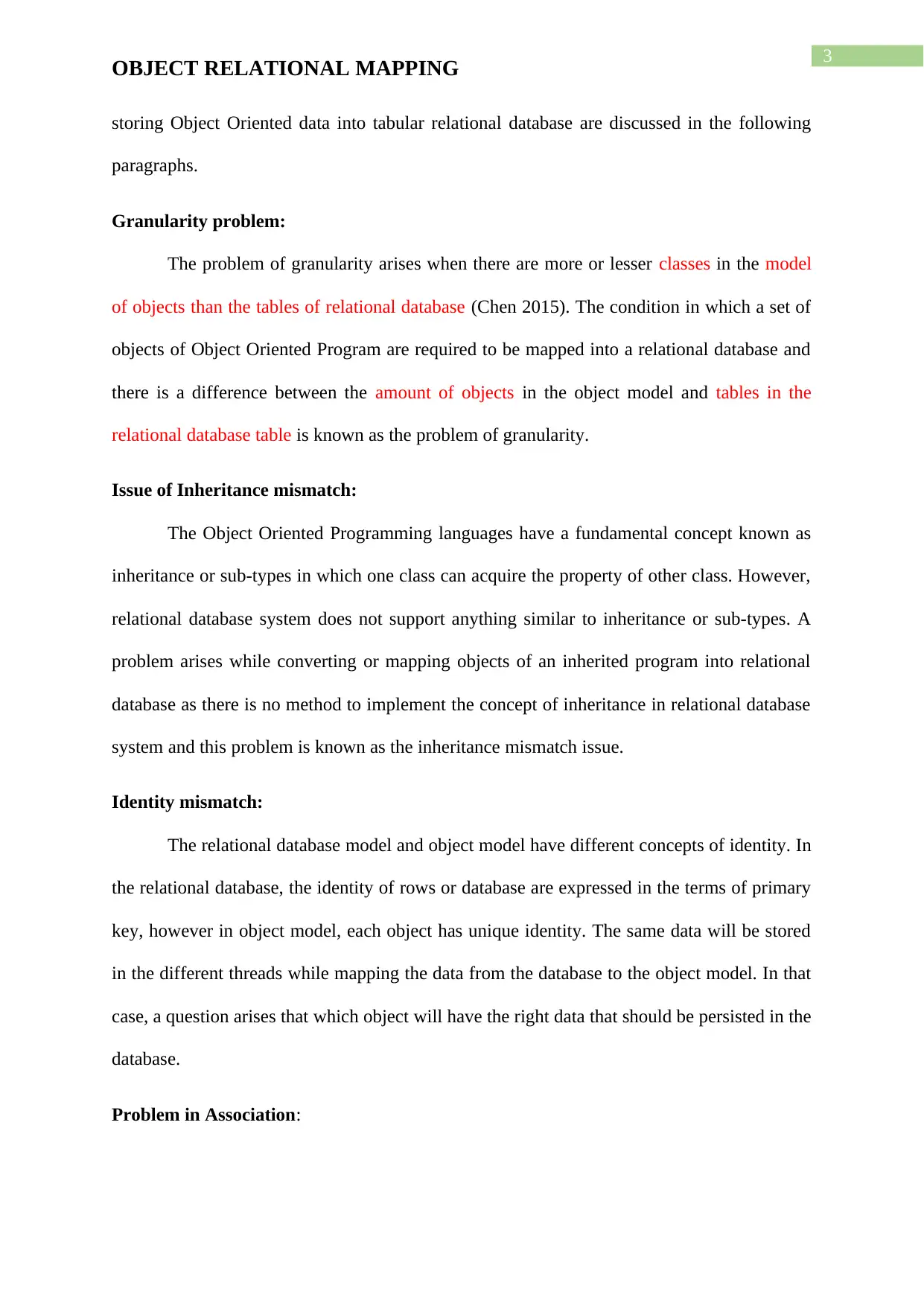
3
OBJECT RELATIONAL MAPPING
storing Object Oriented data into tabular relational database are discussed in the following
paragraphs.
Granularity problem:
The problem of granularity arises when there are more or lesser classes in the model
of objects than the tables of relational database (Chen 2015). The condition in which a set of
objects of Object Oriented Program are required to be mapped into a relational database and
there is a difference between the amount of objects in the object model and tables in the
relational database table is known as the problem of granularity.
Issue of Inheritance mismatch:
The Object Oriented Programming languages have a fundamental concept known as
inheritance or sub-types in which one class can acquire the property of other class. However,
relational database system does not support anything similar to inheritance or sub-types. A
problem arises while converting or mapping objects of an inherited program into relational
database as there is no method to implement the concept of inheritance in relational database
system and this problem is known as the inheritance mismatch issue.
Identity mismatch:
The relational database model and object model have different concepts of identity. In
the relational database, the identity of rows or database are expressed in the terms of primary
key, however in object model, each object has unique identity. The same data will be stored
in the different threads while mapping the data from the database to the object model. In that
case, a question arises that which object will have the right data that should be persisted in the
database.
Problem in Association:
OBJECT RELATIONAL MAPPING
storing Object Oriented data into tabular relational database are discussed in the following
paragraphs.
Granularity problem:
The problem of granularity arises when there are more or lesser classes in the model
of objects than the tables of relational database (Chen 2015). The condition in which a set of
objects of Object Oriented Program are required to be mapped into a relational database and
there is a difference between the amount of objects in the object model and tables in the
relational database table is known as the problem of granularity.
Issue of Inheritance mismatch:
The Object Oriented Programming languages have a fundamental concept known as
inheritance or sub-types in which one class can acquire the property of other class. However,
relational database system does not support anything similar to inheritance or sub-types. A
problem arises while converting or mapping objects of an inherited program into relational
database as there is no method to implement the concept of inheritance in relational database
system and this problem is known as the inheritance mismatch issue.
Identity mismatch:
The relational database model and object model have different concepts of identity. In
the relational database, the identity of rows or database are expressed in the terms of primary
key, however in object model, each object has unique identity. The same data will be stored
in the different threads while mapping the data from the database to the object model. In that
case, a question arises that which object will have the right data that should be persisted in the
database.
Problem in Association:
Paraphrase This Document
Need a fresh take? Get an instant paraphrase of this document with our AI Paraphraser
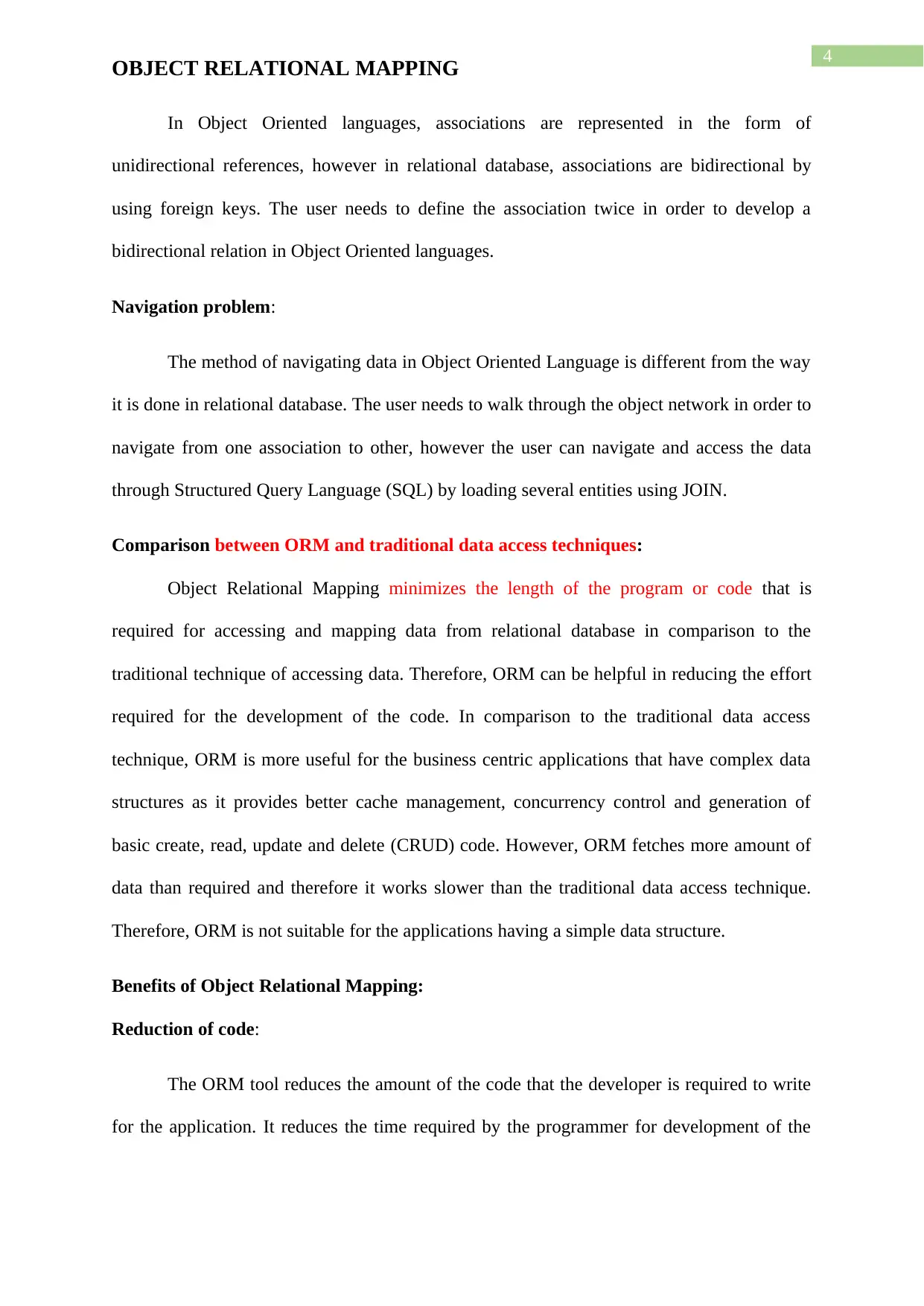
4
OBJECT RELATIONAL MAPPING
In Object Oriented languages, associations are represented in the form of
unidirectional references, however in relational database, associations are bidirectional by
using foreign keys. The user needs to define the association twice in order to develop a
bidirectional relation in Object Oriented languages.
Navigation problem:
The method of navigating data in Object Oriented Language is different from the way
it is done in relational database. The user needs to walk through the object network in order to
navigate from one association to other, however the user can navigate and access the data
through Structured Query Language (SQL) by loading several entities using JOIN.
Comparison between ORM and traditional data access techniques:
Object Relational Mapping minimizes the length of the program or code that is
required for accessing and mapping data from relational database in comparison to the
traditional technique of accessing data. Therefore, ORM can be helpful in reducing the effort
required for the development of the code. In comparison to the traditional data access
technique, ORM is more useful for the business centric applications that have complex data
structures as it provides better cache management, concurrency control and generation of
basic create, read, update and delete (CRUD) code. However, ORM fetches more amount of
data than required and therefore it works slower than the traditional data access technique.
Therefore, ORM is not suitable for the applications having a simple data structure.
Benefits of Object Relational Mapping:
Reduction of code:
The ORM tool reduces the amount of the code that the developer is required to write
for the application. It reduces the time required by the programmer for development of the
OBJECT RELATIONAL MAPPING
In Object Oriented languages, associations are represented in the form of
unidirectional references, however in relational database, associations are bidirectional by
using foreign keys. The user needs to define the association twice in order to develop a
bidirectional relation in Object Oriented languages.
Navigation problem:
The method of navigating data in Object Oriented Language is different from the way
it is done in relational database. The user needs to walk through the object network in order to
navigate from one association to other, however the user can navigate and access the data
through Structured Query Language (SQL) by loading several entities using JOIN.
Comparison between ORM and traditional data access techniques:
Object Relational Mapping minimizes the length of the program or code that is
required for accessing and mapping data from relational database in comparison to the
traditional technique of accessing data. Therefore, ORM can be helpful in reducing the effort
required for the development of the code. In comparison to the traditional data access
technique, ORM is more useful for the business centric applications that have complex data
structures as it provides better cache management, concurrency control and generation of
basic create, read, update and delete (CRUD) code. However, ORM fetches more amount of
data than required and therefore it works slower than the traditional data access technique.
Therefore, ORM is not suitable for the applications having a simple data structure.
Benefits of Object Relational Mapping:
Reduction of code:
The ORM tool reduces the amount of the code that the developer is required to write
for the application. It reduces the time required by the programmer for development of the
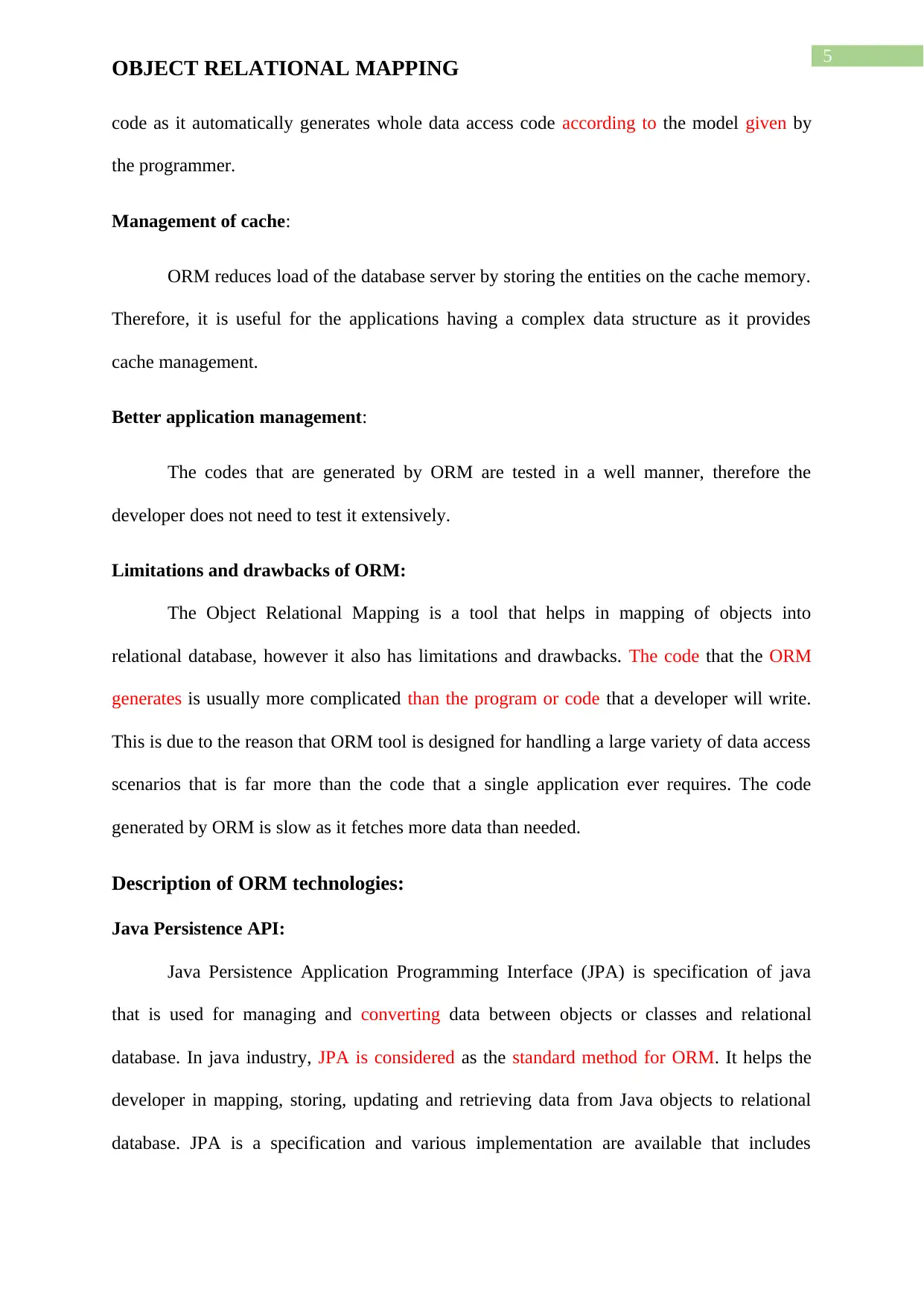
5
OBJECT RELATIONAL MAPPING
code as it automatically generates whole data access code according to the model given by
the programmer.
Management of cache:
ORM reduces load of the database server by storing the entities on the cache memory.
Therefore, it is useful for the applications having a complex data structure as it provides
cache management.
Better application management:
The codes that are generated by ORM are tested in a well manner, therefore the
developer does not need to test it extensively.
Limitations and drawbacks of ORM:
The Object Relational Mapping is a tool that helps in mapping of objects into
relational database, however it also has limitations and drawbacks. The code that the ORM
generates is usually more complicated than the program or code that a developer will write.
This is due to the reason that ORM tool is designed for handling a large variety of data access
scenarios that is far more than the code that a single application ever requires. The code
generated by ORM is slow as it fetches more data than needed.
Description of ORM technologies:
Java Persistence API:
Java Persistence Application Programming Interface (JPA) is specification of java
that is used for managing and converting data between objects or classes and relational
database. In java industry, JPA is considered as the standard method for ORM. It helps the
developer in mapping, storing, updating and retrieving data from Java objects to relational
database. JPA is a specification and various implementation are available that includes
OBJECT RELATIONAL MAPPING
code as it automatically generates whole data access code according to the model given by
the programmer.
Management of cache:
ORM reduces load of the database server by storing the entities on the cache memory.
Therefore, it is useful for the applications having a complex data structure as it provides
cache management.
Better application management:
The codes that are generated by ORM are tested in a well manner, therefore the
developer does not need to test it extensively.
Limitations and drawbacks of ORM:
The Object Relational Mapping is a tool that helps in mapping of objects into
relational database, however it also has limitations and drawbacks. The code that the ORM
generates is usually more complicated than the program or code that a developer will write.
This is due to the reason that ORM tool is designed for handling a large variety of data access
scenarios that is far more than the code that a single application ever requires. The code
generated by ORM is slow as it fetches more data than needed.
Description of ORM technologies:
Java Persistence API:
Java Persistence Application Programming Interface (JPA) is specification of java
that is used for managing and converting data between objects or classes and relational
database. In java industry, JPA is considered as the standard method for ORM. It helps the
developer in mapping, storing, updating and retrieving data from Java objects to relational
database. JPA is a specification and various implementation are available that includes
⊘ This is a preview!⊘
Do you want full access?
Subscribe today to unlock all pages.

Trusted by 1+ million students worldwide
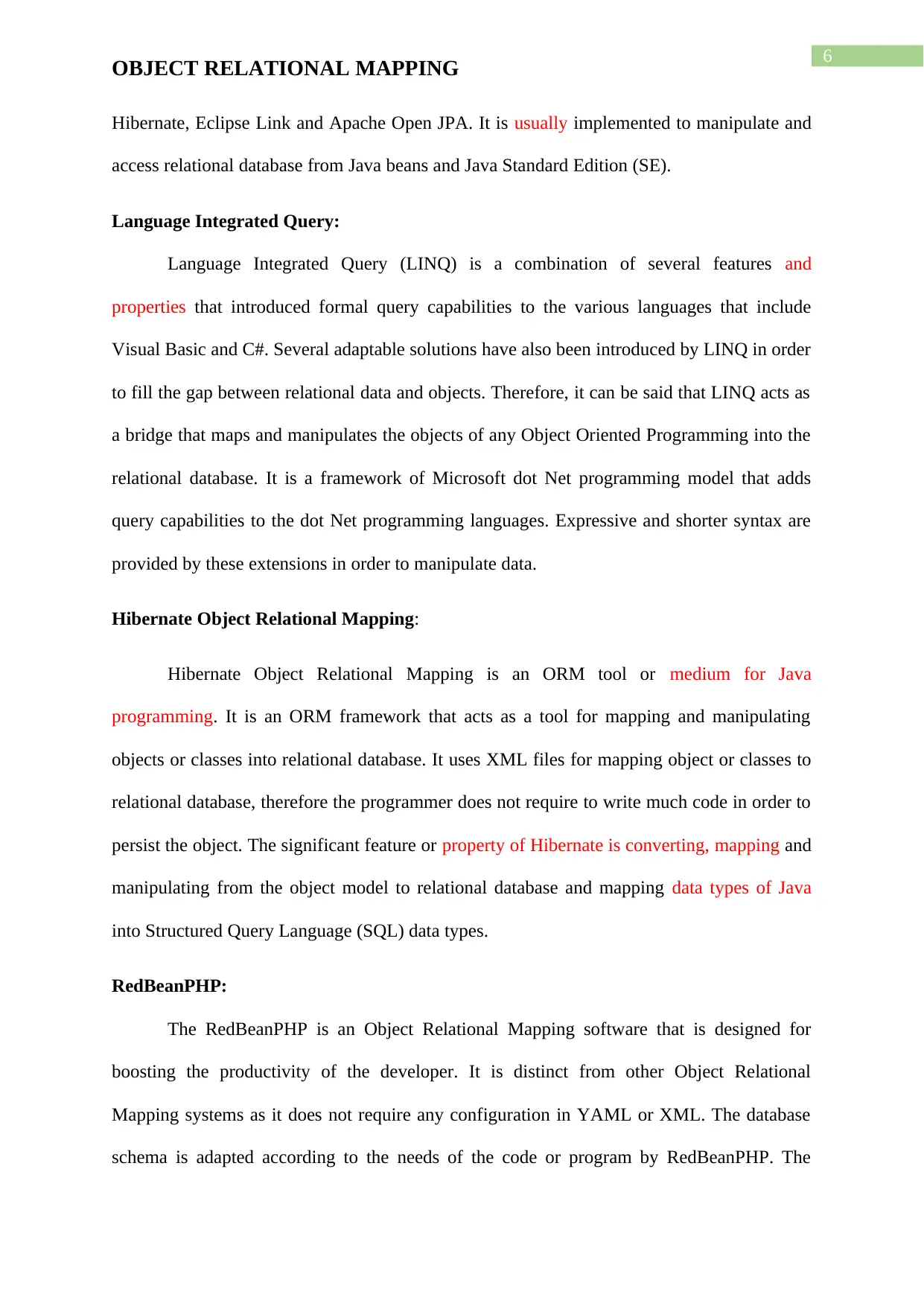
6
OBJECT RELATIONAL MAPPING
Hibernate, Eclipse Link and Apache Open JPA. It is usually implemented to manipulate and
access relational database from Java beans and Java Standard Edition (SE).
Language Integrated Query:
Language Integrated Query (LINQ) is a combination of several features and
properties that introduced formal query capabilities to the various languages that include
Visual Basic and C#. Several adaptable solutions have also been introduced by LINQ in order
to fill the gap between relational data and objects. Therefore, it can be said that LINQ acts as
a bridge that maps and manipulates the objects of any Object Oriented Programming into the
relational database. It is a framework of Microsoft dot Net programming model that adds
query capabilities to the dot Net programming languages. Expressive and shorter syntax are
provided by these extensions in order to manipulate data.
Hibernate Object Relational Mapping:
Hibernate Object Relational Mapping is an ORM tool or medium for Java
programming. It is an ORM framework that acts as a tool for mapping and manipulating
objects or classes into relational database. It uses XML files for mapping object or classes to
relational database, therefore the programmer does not require to write much code in order to
persist the object. The significant feature or property of Hibernate is converting, mapping and
manipulating from the object model to relational database and mapping data types of Java
into Structured Query Language (SQL) data types.
RedBeanPHP:
The RedBeanPHP is an Object Relational Mapping software that is designed for
boosting the productivity of the developer. It is distinct from other Object Relational
Mapping systems as it does not require any configuration in YAML or XML. The database
schema is adapted according to the needs of the code or program by RedBeanPHP. The
OBJECT RELATIONAL MAPPING
Hibernate, Eclipse Link and Apache Open JPA. It is usually implemented to manipulate and
access relational database from Java beans and Java Standard Edition (SE).
Language Integrated Query:
Language Integrated Query (LINQ) is a combination of several features and
properties that introduced formal query capabilities to the various languages that include
Visual Basic and C#. Several adaptable solutions have also been introduced by LINQ in order
to fill the gap between relational data and objects. Therefore, it can be said that LINQ acts as
a bridge that maps and manipulates the objects of any Object Oriented Programming into the
relational database. It is a framework of Microsoft dot Net programming model that adds
query capabilities to the dot Net programming languages. Expressive and shorter syntax are
provided by these extensions in order to manipulate data.
Hibernate Object Relational Mapping:
Hibernate Object Relational Mapping is an ORM tool or medium for Java
programming. It is an ORM framework that acts as a tool for mapping and manipulating
objects or classes into relational database. It uses XML files for mapping object or classes to
relational database, therefore the programmer does not require to write much code in order to
persist the object. The significant feature or property of Hibernate is converting, mapping and
manipulating from the object model to relational database and mapping data types of Java
into Structured Query Language (SQL) data types.
RedBeanPHP:
The RedBeanPHP is an Object Relational Mapping software that is designed for
boosting the productivity of the developer. It is distinct from other Object Relational
Mapping systems as it does not require any configuration in YAML or XML. The database
schema is adapted according to the needs of the code or program by RedBeanPHP. The
Paraphrase This Document
Need a fresh take? Get an instant paraphrase of this document with our AI Paraphraser
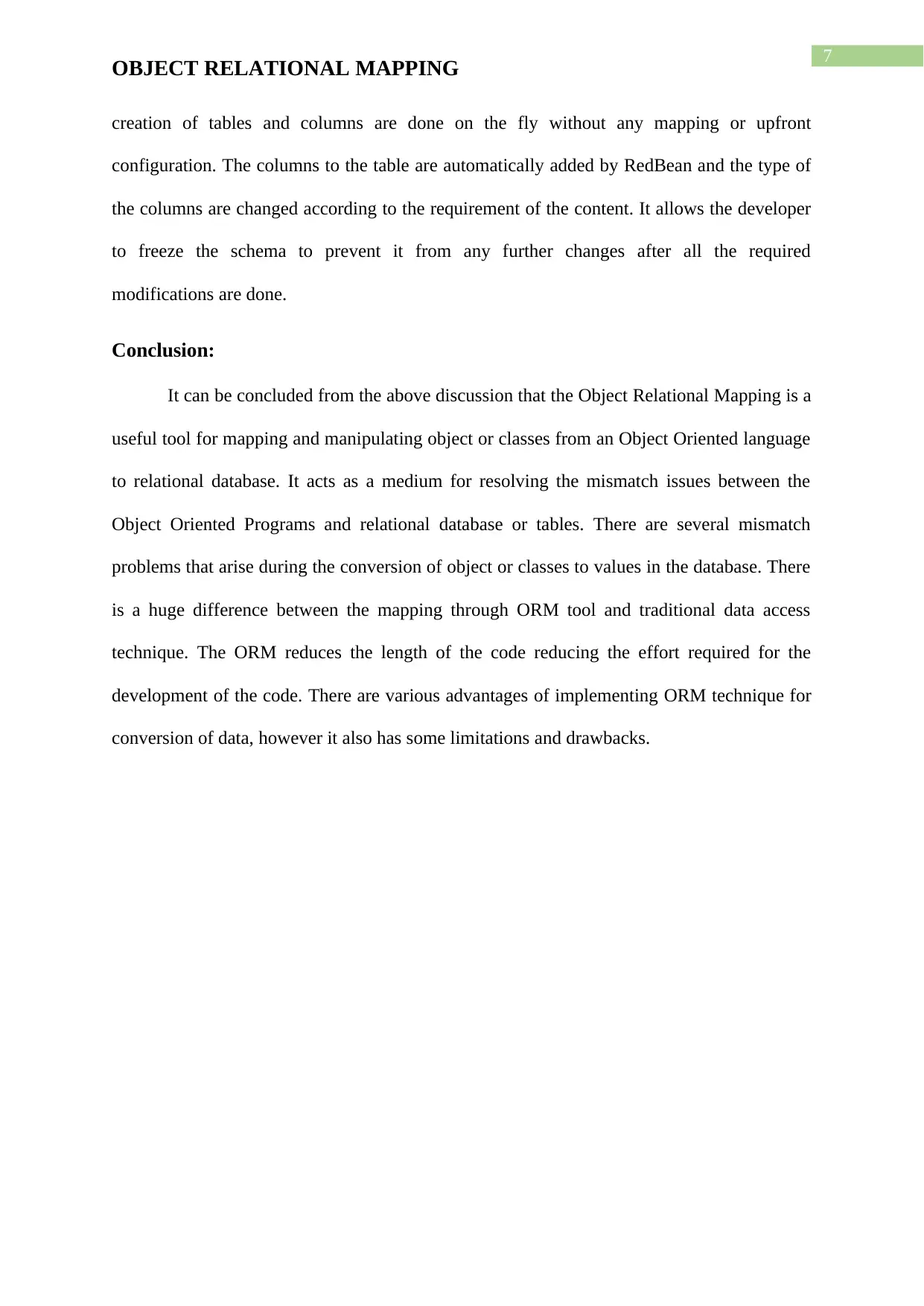
7
OBJECT RELATIONAL MAPPING
creation of tables and columns are done on the fly without any mapping or upfront
configuration. The columns to the table are automatically added by RedBean and the type of
the columns are changed according to the requirement of the content. It allows the developer
to freeze the schema to prevent it from any further changes after all the required
modifications are done.
Conclusion:
It can be concluded from the above discussion that the Object Relational Mapping is a
useful tool for mapping and manipulating object or classes from an Object Oriented language
to relational database. It acts as a medium for resolving the mismatch issues between the
Object Oriented Programs and relational database or tables. There are several mismatch
problems that arise during the conversion of object or classes to values in the database. There
is a huge difference between the mapping through ORM tool and traditional data access
technique. The ORM reduces the length of the code reducing the effort required for the
development of the code. There are various advantages of implementing ORM technique for
conversion of data, however it also has some limitations and drawbacks.
OBJECT RELATIONAL MAPPING
creation of tables and columns are done on the fly without any mapping or upfront
configuration. The columns to the table are automatically added by RedBean and the type of
the columns are changed according to the requirement of the content. It allows the developer
to freeze the schema to prevent it from any further changes after all the required
modifications are done.
Conclusion:
It can be concluded from the above discussion that the Object Relational Mapping is a
useful tool for mapping and manipulating object or classes from an Object Oriented language
to relational database. It acts as a medium for resolving the mismatch issues between the
Object Oriented Programs and relational database or tables. There are several mismatch
problems that arise during the conversion of object or classes to values in the database. There
is a huge difference between the mapping through ORM tool and traditional data access
technique. The ORM reduces the length of the code reducing the effort required for the
development of the code. There are various advantages of implementing ORM technique for
conversion of data, however it also has some limitations and drawbacks.
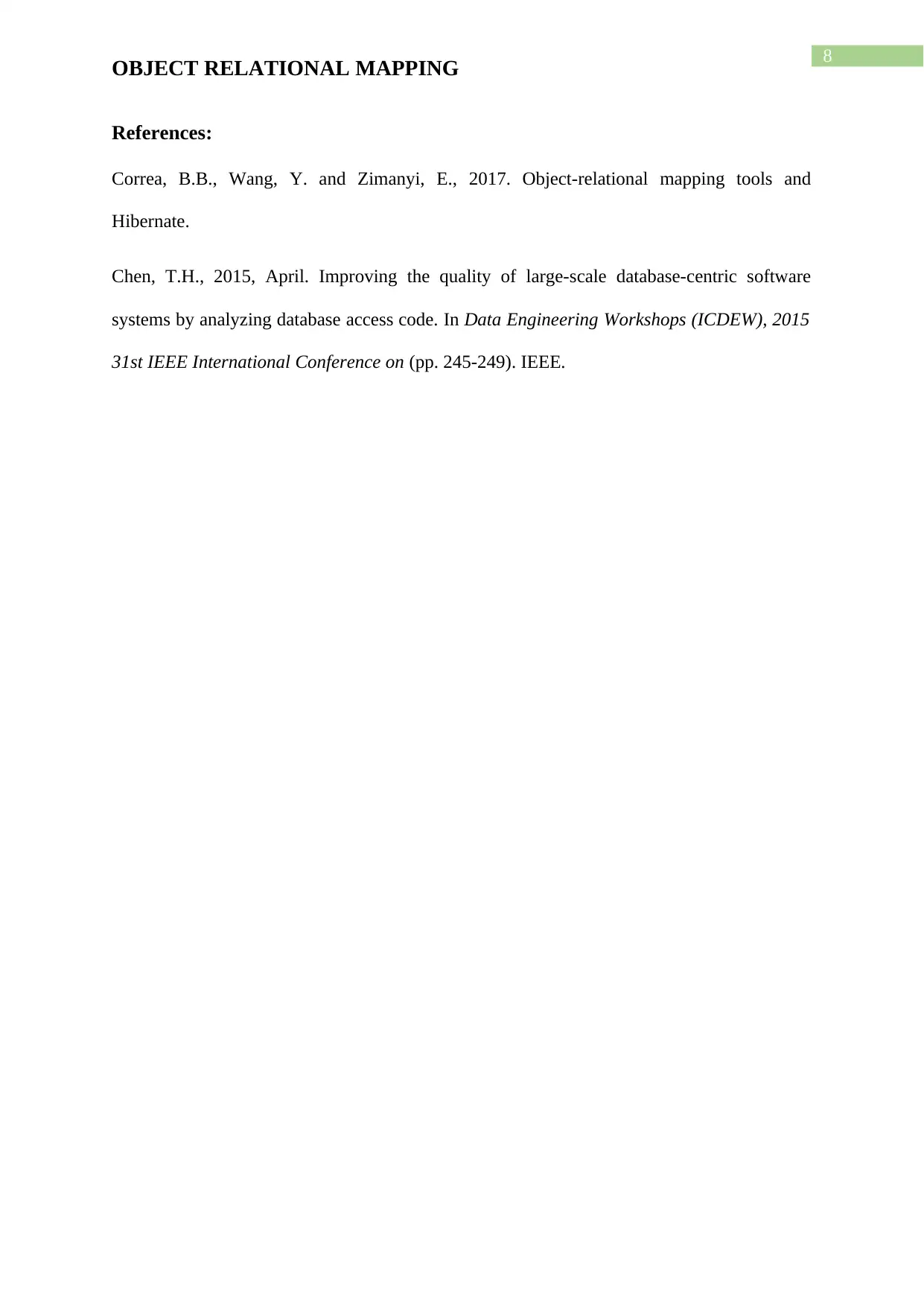
8
OBJECT RELATIONAL MAPPING
References:
Correa, B.B., Wang, Y. and Zimanyi, E., 2017. Object-relational mapping tools and
Hibernate.
Chen, T.H., 2015, April. Improving the quality of large-scale database-centric software
systems by analyzing database access code. In Data Engineering Workshops (ICDEW), 2015
31st IEEE International Conference on (pp. 245-249). IEEE.
OBJECT RELATIONAL MAPPING
References:
Correa, B.B., Wang, Y. and Zimanyi, E., 2017. Object-relational mapping tools and
Hibernate.
Chen, T.H., 2015, April. Improving the quality of large-scale database-centric software
systems by analyzing database access code. In Data Engineering Workshops (ICDEW), 2015
31st IEEE International Conference on (pp. 245-249). IEEE.
⊘ This is a preview!⊘
Do you want full access?
Subscribe today to unlock all pages.

Trusted by 1+ million students worldwide
1 out of 9
Related Documents
Your All-in-One AI-Powered Toolkit for Academic Success.
+13062052269
info@desklib.com
Available 24*7 on WhatsApp / Email
![[object Object]](/_next/static/media/star-bottom.7253800d.svg)
Unlock your academic potential
Copyright © 2020–2025 A2Z Services. All Rights Reserved. Developed and managed by ZUCOL.





